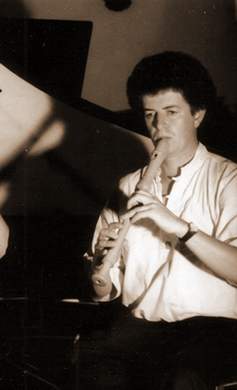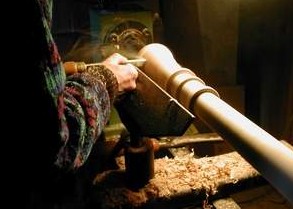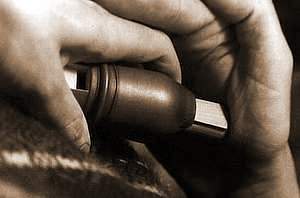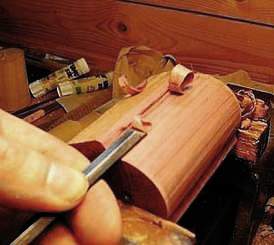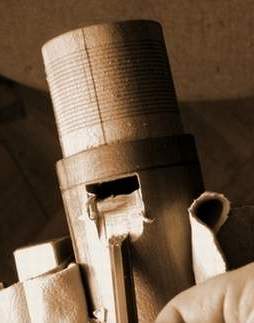 |
Bruno Reinhard Recorder Maker |
489 chemin du bouquier 84330 Caromb - FRANCE Tel. : +33 04 90 62 39 20 |
To begin with, I would like to say a few words about my youth whose pastimes have become my present day passions. I played the piano, the recorder, and the transverse flute, as well as all the Latin American flutes in various ensembles. I also loved to build things, especially out of wood, and that eventually led me, when I was seventeen, to making an epinette (small harpsichord) from A to Z with what little know-how I had back then. In 1976, after finishing high school, I studied musicology at the University of Strasbourg which at the time offered a diploma in early music, including courses on analysis, notation, and the study of early music treatises. I was a very enthusiastic student and, at the same time, I taught recorder lessons in several music schools and gave concerts with several ensembles. In October of 1980 I moved to Provence with 15 orders for my first recorder model, a 17 th c. soprano (handfluit) in A 415 that I had elaborated while I was still a student. At that time, it was quite in demand; no one made that type of recorder in France. I, myself, had wanted to get a hold of one.
I continued to teach the recorder in several music schools and I gave a few concerts each year. In 1989 I obtained the ‘Diplôme d’Etat’ in early music, a national music teachers’ diploma. As an instrument maker, I privilege a limited production and each instrument is unique. The recorder is not an easy instrument to make and to understand. (Acousticians still don’t understand how it works.) Recorder making demands an incredible amount of concentration, tiring the ear and the mind. Two elements are at the base of my craftsmanship: precise gestures and time. Every gesture has my complete attention and the result is that from time to time I even arrive at that ‘magic’ recorder that no machine could ever produce. Unlike other wind instruments such as the oboe, the clarinet, and the modern flute, the sound of the recorder is made in the beak. This type of construction requires extremely fine adjustments, as fine as a tenth of a millimeter . (Imagine that brushing the edge of the chamfer at the exit of the canal delicately, even with the finest abrasive, is sufficient to completely modify the sound.)
I also need time to ‘age’ a recorder, to play it, to feel its tone, attacks, ‘homogeneity’, its particular color and ease in each register. A new recorder is very unstable, which you know if you break in your own instruments. The wood adjusts, moves, and settles into place little by little as the player’s humid air breathes life into it. It is most important for me to wait for this ‘renaissance’ before entrusting your recorder to you. So I play each recorder for many hours before you receive it. As a recorder player, I suffered too much from playing instruments which had beautiful middle registers but were practically unplayable for the rest, forcing one to go through incredible gymnastics just to get the notes out. That, of course, greatly hinders the ease and relaxation needed for expressiveness.
So, as a recorder maker, my first pledge is to furnish instruments that ‘play’ and play for a long time. For me, they require these fundamental characteristics: stability, homogeneity, ease in the attacks, being in tune, quality of tone... My second pledge is to listen to your wishes and desires ( esthetical, physiological, tonal, mechanical, ...) and to provide the follow-up and the maintenance of your instrument. And that takes time. My third pledge is to stay as close as possible to original instruments (aside from adjustments in pitch, making some recorders in two parts in order to facilitate tuning, and giving a few double holes to baroque models). Along with using European wood (boxwood, maple and other fruit tree woods), I stain, treat, and oil with traditional means which have stood the test of time. In addition, I invite you to use early fingerings and temperaments: meantone, pythagorian, werkmeister, etc. I want to reconstitute as much as possible those instruments as they existed to play the music of their era, since I am convinced that will help you to interpret that music in the best way. This, of course, does not preclude the elaboration of an entirely different recorder, a modern instrument for playing modern music.
You, yourself, are also an actor in the harmonic development of your recorder. The way that you break it in and play it and the care that you give it take part in transforming its sonority. The magic intertwining of these elements will enhance your recorder; and like a good wine, nothing will enhance your recorder as will time, said so well by Quantz in his treatise. Furthermore, I would like to invite you to explore all the possibilities of your recorder by adding your personal touch. Your work associated with mine will make your instrument unique. I hope to follow your recorder over the years in order to maintain it in the best possible form. It is this very contact with you, the player, that I wish to have. The more that I am familiar with your way of playing, the better I can work with you. Thanks to you, my work is constantly progressing. It is my greatest fortune to have the confidence of many recorder players who play my instruments daily at the highest levels, making recordings, giving concerts and teaching. They are my best showcase and I thank them. I hope to have shared with you my desire for a limited production with an intimate character, privileging a warm and personal touch over standardization and quantity. For over twenty years I have held this difficult balance in an economic market that is trying to eliminate the notions of time and quality craftsmanship. I hope to hold on for another twenty.
A warm thanks to all Bruno
|
||||||||
